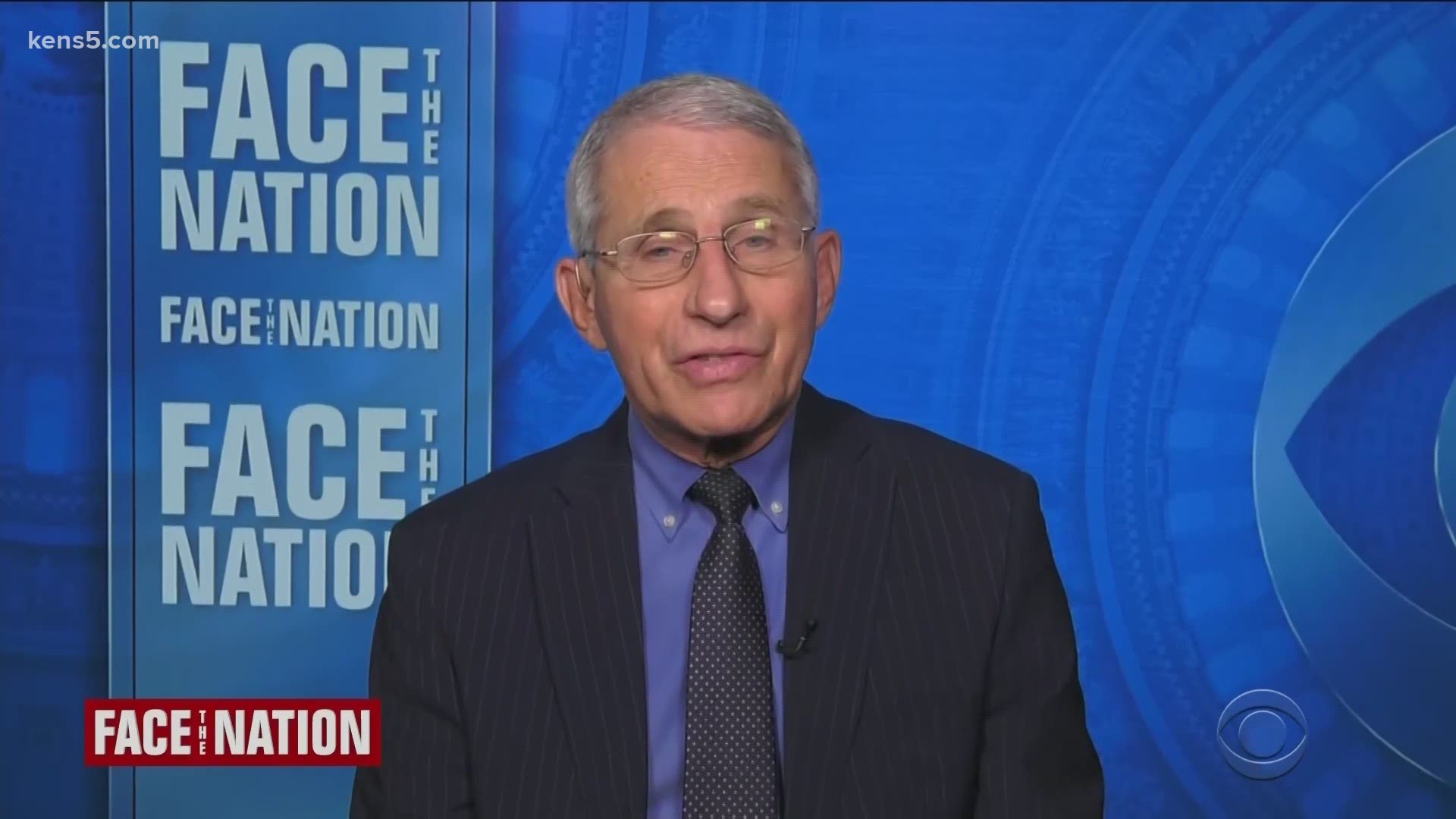SAN ANTONIO — From lockdowns to mask mandates to social distancing, the pandemic protocols have unfortunately become a way of life for San Antonians. The pandemic began affecting the Alamo City in February 2020 when travelers from Wuhan, China, were brought to a federal quarantine site at Lackland Air Force Base.
More than a year later, hundreds of thousands of people in San Antonio have tested positive for COVID-19 and sadly, thousands of people have died from the virus. But, there is hope. Late in 2020, people began getting the fast-tracked COVID-19 vaccine, and health officials say the results are already starting to show.
Below is a timeline of pandemic-related events that have affected San Antonio:
February 7: Quarantined travelers
Travelers being quarantined in relation to the coronavirus outbreak arrived in San Antonio, touching down at Kelly Field.
Health officials said the plane carried fewer than 100 passengers, including at least two children, who would be held at Lackland Air Force Base for a two-week quarantine.
February 13: First case among evacuees
Health officials announced the first case of coronavirus among the people who had been evacuated from China to Lackland Air Force Base in San Antonio. The patient was stable condition is in isolation at a nearby hospital.
February 16: Cruise ship passengers
Several passengers from the cruise ship Diamond Princess were brought to the federal quarantine site at Lackland Air Force Base. Health officials said seven of them tested positive for the novel coronavirus while two of those were said to have a fever.


February 28: Quarantine cases
San Antonio Metro Health confirmed there were a total of 11 cases of coronavirus stemming from the quarantine throughout February at Lackland.
Nine of those people confirmed to have coronavirus are among the group of Diamond Princess cruise ship passengers currently under federal quarantine at Joint Base San Antonio-Lackland.
Another patient confirmed with the virus was flown in from California this week to be treated, according to Metro Health.
February 29: North Star Mall cleaned
Metro Health San Antonio reported that a patient who may have been positive with the coronavirus visited North Star Mall on Saturday, February 29.
Health officials said the patient tested negative for the virus twice before leaving quarantine at JBSA-Lackland, which met CDC guidelines at the time for release. She was out in public for about 12 hours before a third test came back with a weak positive.
North Star Mall conducted a deep clean of the facilities before reopening to the public, and even a school was deep cleaned because a teacher there was working part time at the mall on the day the person visited.

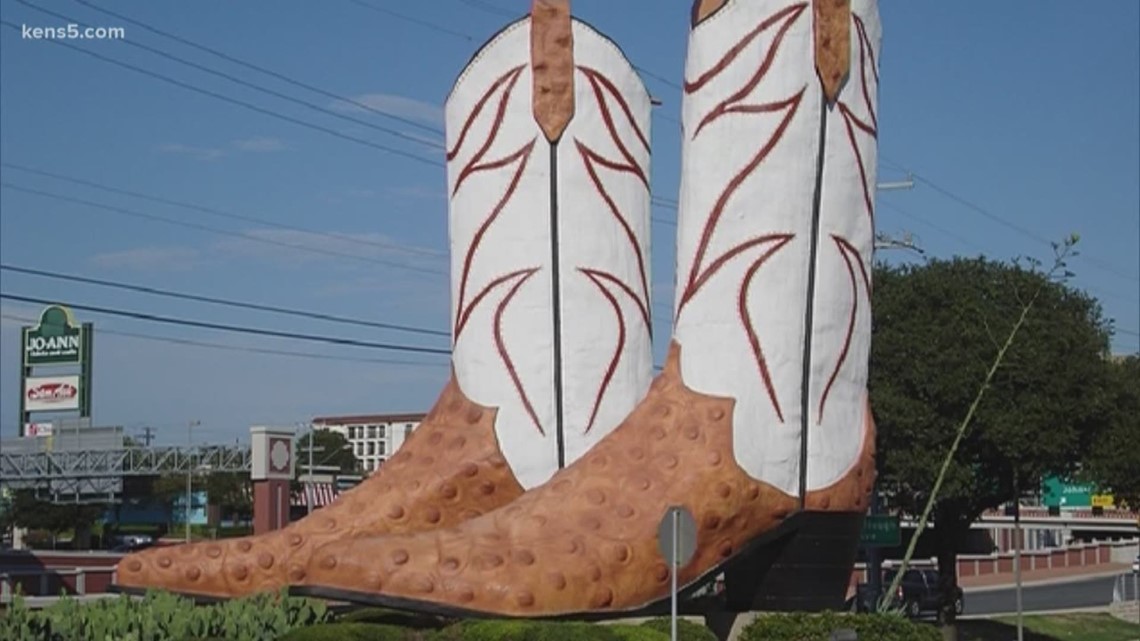
March 2: Public health emergency
San Antonio Mayor Ron Nirenberg declared a "local state of disaster and a public health emergency" over concerns about the spread of coronavirus.
It also allowed the city to "take any actions necessary to promote health and suppress disease, including quarantine, examining and regulating hospitals, (and) regulating ingress and egress from the city."
Bexar County Judge Nelson Wolff joined the mayor and also issued a declaration of public health emergency.
March 11: Pandemic classification
The World Health Organization classifies the worldwide outbreak of the new coronavirus crisis as a pandemic.
"Describing the situation as a pandemic does not change WHO’s assessment of the threat posed by this coronavirus. It doesn’t change what WHO is doing, and it doesn’t change what countries should do," WHO Director-General Tedros Adhanom Ghebreyesus.
March 12: Spurs games suspended
In a statement released March 12, Spurs, Sports, and Entertainment CEO RC Buford said the organization "fully supports the National Basketball League's decision to indefinitely suspend the remainder of the 2019-2020 season. This came after the NBA's announcement. Spurs official last game before the postponement was March 10 vs. the Mavericks.


March 13: First reported case of COVID-19 in SA announced
San Antonio city and health officials announced that the first case of coronavirus in the city outside of the JBSA-Lackland quarantine had been confirmed by testing.
The person had previously traveled out of state, according to officials.
March 13: Fiesta postponed
Fiesta 2020 was officially postponed until early November. The plan was made with the hope that by November, it would be safe to gather in large crowds again. The November rescheduled dates were eventually canceled along with the Fiesta 2021 which was scheduled for April. The Fiesta Commission's current plan is to prepare for Fiesta 2022 at its scheduled dates in April 2022.

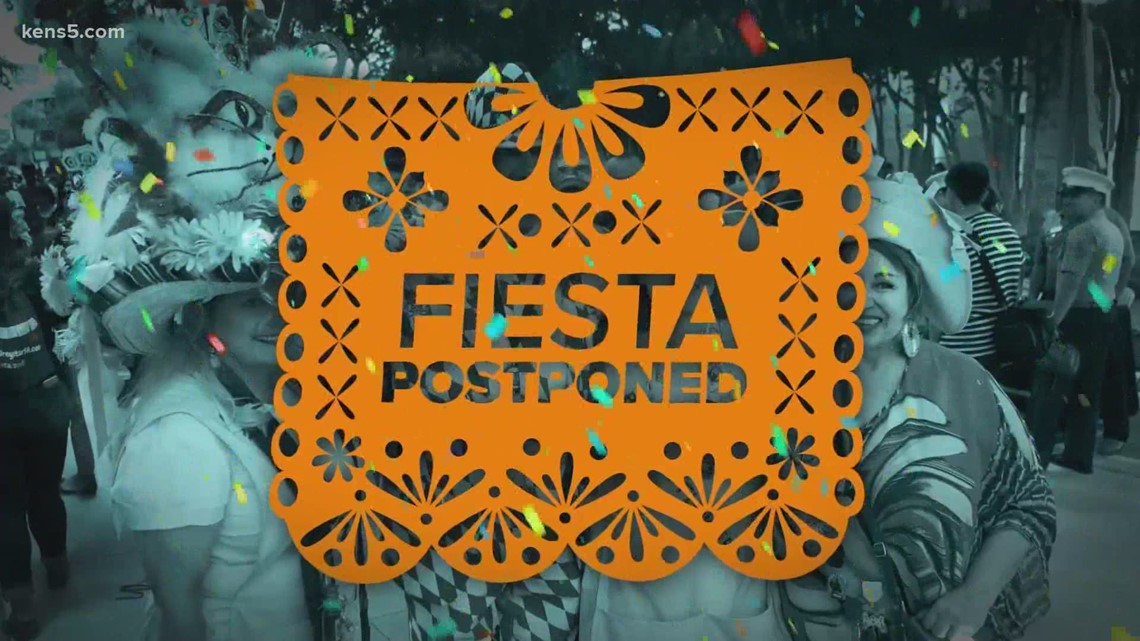
March 16: Schools close
Most school districts in the San Antonio area were supposed to have students return after spring break on Monday, March 16, but during the break, it was announced that it would be extended. Governor Greg Abbott would eventually extended the closure of in-person learning to the entire 2019-2020 school year. Virtual and distance learning procedures emerged from the closure.
March 18: Restaurants close
Mayor Ron Nirenberg ordered dine-in services at restaurants will be suspended; additionally, bars, bowling alleys, fitness centers and other "non-essential businesses" were to close.
March 19, 2020: Community spread confirmed
Metro Health announced the first confirmed cases of "community spread" of the coronavirus in Bexar County. Previously, all confirmed cases had been travel-related or close contact with someone who had traveled.
March 22: First COVID-19 related death in Bexar County reported
Officials with the City of San Antonio and Bexar County confirm the first coronavirus-related death. The deceased was a woman in her 80s with a history of underlying health issues.
March 23: 'Stay Home, Work Safe'
San Antonio Mayor Ron Nirenberg announced the "Stay Home, Work Safe Order." Under the order, individuals living within San Antonio are ordered to stay home, only leaving the house to "perform allowed activities." The initial order was to stay in effect until April 9. That was later extended multiple times.


March 26: Self-quarantine for travelers
Gov. Abbott issued an executive order requiring anyone traveling from New York or New Orleans, considered to be hot spots at the time, to mandatory self-quarantine for 14 days.
March 28: Economic relief bill
The largest economic relief bill in U.S. history was passed by Congress and signed into law, paving the way for $2.2 trillion in aid for individuals, businesses, workers and health care systems engulfed by the coronavirus pandemic.
The bill provided one-time direct payments to Americans of up to $1,200 per individual adults and $2,400 for married couples, plus an additional $500 for each eligible child.
March 31: State 'stay home' order
Governor Abbott issues a state-wide version of a "stay home" order. The governor expanded his previous executive order, which meant Texans were expected to stay home unless they are doing an activity or work somewhere listed as essential.
April 12: Easter in a pandemic
San Antonio celebrated its first major holiday in a pandemic as people observed Easter on April 12. City and county leaders urged church leaders to live stream their Easter services and parks in San Antonio were closed to the traditional Easter camping.


April 22: Big Give relief fund
The Big Give Emergency Relief fund was up to $500,000 through donations. Back in March, the Nonprofit Council directed it's annual "Big Give SA" effort into an emergency relief fund for nonprofit groups in 15 south Texas counties due to coronavirus. The effort helps than 500 area nonprofits currently experiencing strains on their services and operations because of the pandemic and continued into 2021.
May 1: Economy begins to reopen
Under Greg Abbott's executive order, restaurants were allowed to reopen to in person dining at 25 percent capacity. The reopening was part of a phased reopening of the Texas and San Antonio economies. At that point, the COVID-19 pandemic had led to more than 700,000 layoffs.
June 26: Bars and tubing outfitters close
After reopening most parts of the economy, Governor Greg Abbott ordered the closing of bars and tubing and rafting outfitters. Daily case counts of COVID-19 continued to climb throughout June and these businesses were identified as potential sources of the spread. At this time, the governor also ordered restaurants to limit capacity.


July 3: State-wide mask order
Texas Governor Greg Abbott issued an Executive Order requiring all Texans to wear a face covering over the nose and mouth in public spaces in counties with 20 or more positive COVID-19 cases, with few exceptions. This rule stayed in place until March 10, 2021, when the Governor rescinded the mask order against the advice of federal health officials.
July 4: Independence Day in a pandemic
San Antonio celebrated another major holiday in a pandemic. July Fourth, known for family gatherings, barbecue, parties, and of course, fireworks, was derailed by concerns of the spread of COVID-19 and increasing case counts in Bexar County and Texas. Most fireworks celebrations were canceled or made into drive-through events. City leaders urged people to stay home and celebrate only among their households.

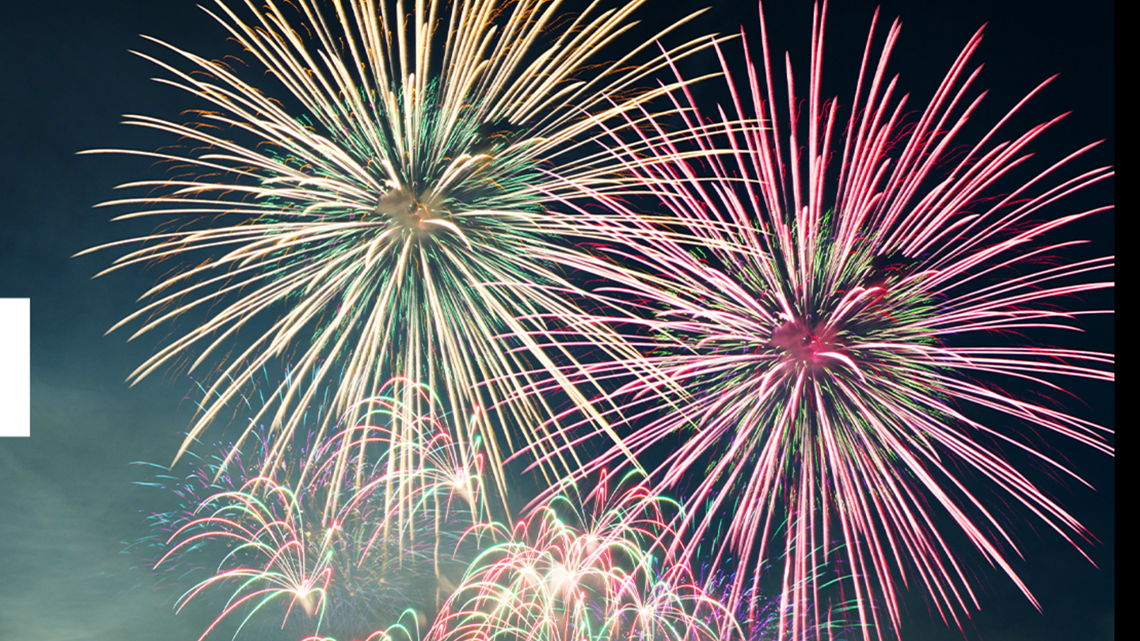
July 28: Summer peak of COVID-19 cases
After a steady climb in daily cases of COVID-19, the summer spike reached a peek of 1,546 cases on July 28, 2020. This was roughly three weeks after the July Fourth holiday. After that date, the cases continued to go down, but another spike would occur during the 2020 winter holidays.

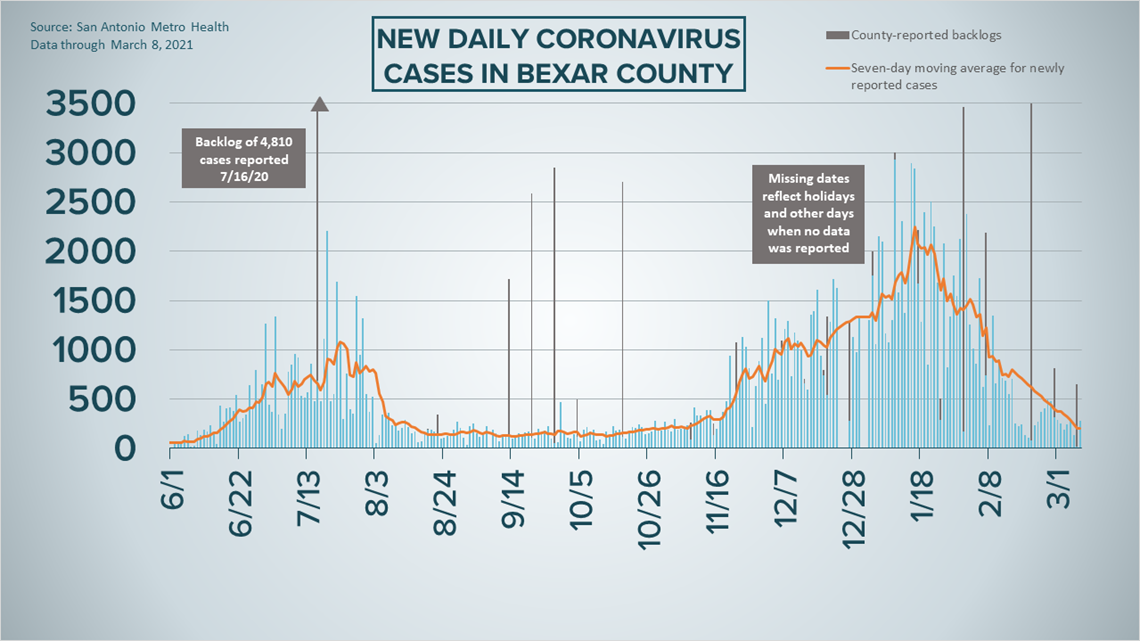
July 31: Spurs in a bubble
After the NBA season came to a screaching halt, the Spurs, along with other teams, resumed their games in a "bubble"-like environment where players and staff are quarantined and tested frequently. Their first game inside the NBA bubble was Friday, July 31 and last game in the bubble was Thursday, August 13.
August 17: School year gets off to unsteady start
Many schools districts around the area kicked off the new school year in a pandemic. While most districts in the San Antonio area started the year with at least a few weeks of virtual learning for all students, other districts in the Hill Country areas, include Boerne ISD and Comal ISD, opened to in person learning as soon as school started. Mask mandates, social distancing measures, and extensive cleaning and santizing were implemented. More uban districts followed suit in early September.
September 6: Parks close for Labor Day
Repeating a similar safety measure that was implemented in July, Bexar County Judge Nelson Wolff said on August 12 that all county parks will be closed for the Labor Day holiday, in order to continue slowing the spread of COVID-19 in the community.
October 31: Halloween in a pandemic
Another major holiday rolled around while the coronavirus continued to spread in San Antonio.Mayor Ron Nirenberg shared six tips, beginning with the most basic – stay home if you're sick – and going on to include familiar suggestions of social distancing and using hand sanitizer often.


November 19: CDC warns against travel
The Centers for Disease Control and Prevention released new guidance on traveling amid the coronavirus pandemic, a week before Thanksgiving.
Officials with the agency said during a press briefing that traveling could increase someone's chances of getting or spreading COVID-19. Officials with the CDC urged that its guidance is strongly recommended, but not enforced.
December 14: Hope arrives in San Antonio
UT Health San Antonio announced the arrival of 6,000 doses of the Pfizer COVID-19 vaccine. The Pfizer vaccine was approved by the FDA for emergency use and the first phase of people to get the vaccine include healthcare workers and other frontline personnel and first responders.


December 23: Spurs first game of 2020-2021 season
After an interrupted 2019-2020 season, the Spurs kicked off their first game, without fans, on December 23 against the Grizzlies. The Spurs ended up with a 131-119 win over the Grizzlies.
December 29: Phase 1B of vaccine distribution begins
On December 29, the Texas Department of State Health Services (DSHS) announced that it would open up vaccinations to Texans in Phase 1B. That group included people over the age of 65 and people with certain health conditions. Because that included such a large portion of the population of San Antonio, the few organizations offering vaccine appointments experienced a rush of people trying to book appointments, causing websites to crash and phone lines to get jammed.
January 9, 2021: Mass vaccination site
San Antonio officials announced the establishment of a mass vaccination site at the Alamodome. It was also announced this day, that the WellMed Elvira Cisneros Senior Community Center on the southside would operate as a similar no-cost vaccination site, however, appointments for this site would need to be made by phone.


January 16: Winter peek of COVID-19 cases
San Antonio saw another peek of cases on January 16, following a summer peek, but this time, numbers were much higher. The daily COVID-19 case count for that day was a record-high 2,889 cases. Cases would continue to remain high until early February, when a slow decline would continue through March.


February 14-20: Historic winter storm
A massive and historic winter storm hit the South Texas area in the middle of February. The storm brought several inches of ice, snow and sleet, caused a power crisis and brought life to a grinding halt. That meant that vaccine appointment that week had to be rescheduled, and COVID testing that would normally take place was not available. Daily case counts had already been on a steady decline, and health officials expected that trend to continue.


February 15: Four Spurs players test positive
Three San Antonio Spurs games were postponed by the National Basketball Association because of four players testing positive for COVID-19. That's after Tuesday's game was already postponed – for a total of four games were impacted by the pandemic at that point.
March 10: No more mask requirement
Governor Abbott shocked many by announcing he would be removing the mask mandate state-wide on March 10, even though there was evidence that COVID-19 was still spreading in the community. In that same announcement, he said businesses would be allowed to open to 100 percent capacity. Despite that, many businesses said they would still continue to require customers and staff to wear masks.
March 12: Spurs fans welcomed back
For the first time in almost a year, the San Antonio Spurs will allow fans to start attending games in person again.
The San Antonio Spurs will host the Orlando Magic.back fans. The last time they did so before the coronavirus pandemic began was on March 10, 2020.


Coronavirus symptoms
The symptoms of coronavirus can be similar to the flu or a bad cold. Symptoms include fever or chills, cough, shortness of breath or difficulty breathing, fatigue, muscle or body aches, headache, new loss of taste or smell sore throat, congestion or runny nose, nausea or vomiting, and diarrhea, according to the Centers for Disease Control.
Most healthy people will have mild symptoms. A study of more than 72,000 patients by the Centers for Disease Control in China showed 80 percent of the cases there were mild.
But infections can cause pneumonia, severe acute respiratory syndrome, kidney failure, and even death, according to the World Health Organization. Older people with underlying health conditions are most at risk.
Experts determined there was consistent evidence these conditions increase a person's risk, regardless of age:
- Chronic kidney disease
- COPD (chronic obstructive pulmonary disease)
- Obesity (BMI of 30 or higher)
- Immunocompromised state (weakened immune system) from solid organ transplant
- Serious heart conditions, such as heart failure, coronary artery disease, or cardiomyopathies
- Sickle cell disease
- Type 2 diabetes
The CDC believes symptoms may appear anywhere from two to 14 days after being exposed.
Human coronaviruses are usually spread...
- Between people who are in close contact with one another (within about 6 feet).
- Through respiratory droplets produced when an infected person coughs, sneezes or talks. These droplets can land in the mouths or noses of people who are nearby or possibly be inhaled into the lungs.
- Some recent studies have suggested that COVID-19 may be spread by people who are not showing symptoms.
Help stop the spread of coronavirus
- Stay home when you are sick.
- Eat and sleep separately from your family members
- Use different utensils and dishes
- Cover your cough or sneeze with your arm, not your hand.
- If you use a tissue, throw it in the trash.
Find a Testing Location
City officials recommend getting a COVID-19 test if you experience fever or chills, cough, shortness of breath or difficulty breathing, fatigue, muscle or body aches, headache, new loss of taste or smell, sore throat, congestion or runny nose, nausea or vomiting, or diarrhea.
A self-screening tool is available to see if you need a test.
- Who would (and wouldn't) get $1,400 stimulus check under Senate plan
- CDC updates guidance on vaccinated people as vaccine rollout causes mixed emotions
- Service workers rally at Texas Capitol, protesting the lift of the mask mandate
- Smoking increases risk of hospitalization, death from COVID-19, study says
- U.S. considering COVID tests for domestic travel | Connect the Dots
- TABC begins spring break crackdown as Texas prepares to lift COVID-19 restrictions
- H-E-B will keep COVID protocols in place once mask mandate is lifted
- Why vaccines won't bring a quick end to the pandemic

